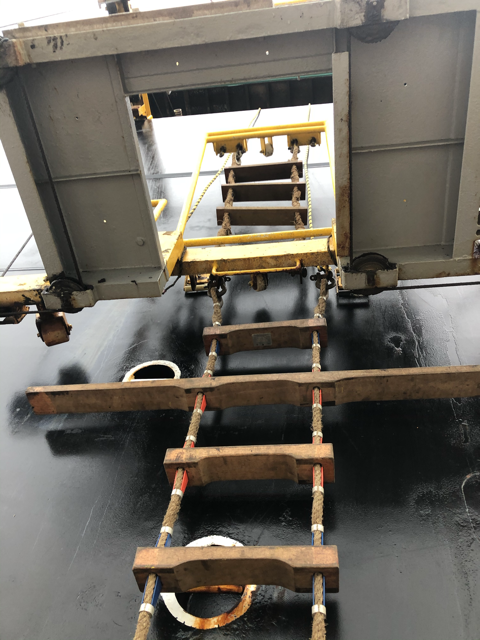The Charity
Aviation
Maritime
Pilots Corner – Why do we get so many pilot ladder reports?

Initial Report
Most seafarers will join and leave different ships two or three times a year and on most occasions via a gangway whilst the vessel is tied up alongside in port. Spare a thought for the marine pilots who guide your ship safely in and out of ports, who regularly embark or disembark from 2 or 3 ships (or more) in a single shift, normally via an arrangement of hairy rope and wood called the ‘pilot ladder’.
Pilot ladders must be important equipment because they come under the SOLAS regulations. For those who might have forgotten, the SOLAS regulations concern Safety Of Life At Sea. With that said, CHIRP questions why we continue to receive a steady stream of reports about non-compliant pilot ladders and pilot boarding arrangements .
Initial report:
Combination pilot ladder with trap door non-compliant.
Further dialogue:
The brief initial report was accompanied by a photograph which clearly illustrated the non-compliance. Whilst CHIRP received the basic report, a more extensive report was sent to the port state maritime administration by the reporter’s professional association, which resulted in two PSC officers attending the vessel on the following day at its next port.
CHIRP contacted the ISM managers and corresponded with the DPA regarding the report.
Previously, in 2019, CHIRP had engaged with the ISM managers regarding a non-compliant pilot boarding arrangement (PBA) report for another of the company’s vessels. On that occasion details had been passed to the DPA, but no further engagement had taken place . On this occasion the DPA volunteered that the vessel reported most recently was a sister ship of the previously reported vessel and both were fitted with the same pilot boarding equipment.
In later correspondence the DPA confirmed that the PSC inspection had taken place but stressed that no deficiency was logged by the PSC officer. However, the email went on “Although we are of the opinion that the PBA is complying with SOLAS requirements, we have decided to make modifications to the PBA. We have instructed the technical department to approach the class & flag to carry out necessary modification”.
CHIRP comment:
CHIRP was surprised to learn that no deficiency had been logged by the PSC officers following their inspection of this vessel.
- There are known issues with pilot boarding arrangements on pre-existing vessels of a certain age.
- Some maritime administrations seem to apply “grandfather rights” in this situation – CHIRP would contest there is no such thing with regards to pilot boarding arrangements. This is clearly a non-compliant arrangement.
- Pilots should be operating to a set of standard operating procedures.
- Not having a set of SOPs puts pressure on the pilot to make do. A pilot should not have to make a decision at the bottom of the ladder.
- Is there a difference between a non-compliant ladder and an unsafe ladder? – CHIRP would argue not. Although some elements of non-compliance are minor, it is a matter of law. The ladder will be compliant to the regulations and if it does not comply it should not be used – it’s law.
- More and more ports and pilotage authorities are refusing to use non-compliant pilot boarding arrangements with more and more ships being turned away until a compliant PBA is presented.
- Ships that continue to present non-compliant PBA’s will be delayed.

PBA as presented: Pilot ladder presented in two sections. Both sections are secured solely to the accommodation ladder platform instead of to the ship. Yellow horizontal frame sections are impeding access during accent or descent.
Report Ends ……………….







